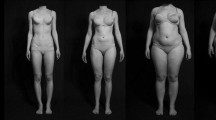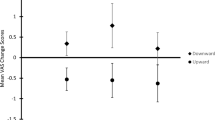Abstract
The current study examined the impact of receiving information about a woman’s eating disorder status on perceptions of the woman’s health and attractiveness. A total of 99 females and 84 males viewed a photo of a model who had disclosed her diagnosis of anorexia nervosa. Participants were randomly divided into three groups: model (M) group (those who were informed that the photo showed a model), eating disorders (ED) group (those who were informed that the photo showed a woman with an eating disorder), and no description control (C) group. Male and female participants in the ED group rated the woman in the photo as less healthy than did participants in the M and C groups. However, there were no differences between groups for ratings of attractiveness or the participants’ desire to achieve a similar look (for females). Additionally, male participants rated the photo as less attractive than female participants had predicted. Finally, internalization of the thin ideal was a significant predictor of ratings of health and attractiveness of the woman in the photo.
Similar content being viewed by others
References
Wiseman CV, Gray JJ, Mosimann JE, et al. Cultural expectations of thinness in women: an update. Int J Eat Disord 1992; 11: 85–9.
Spitzer BL, Henderson KA, Zivian MT. Gender differences in population versus media body sizes: a comparison over four decades. Sex Roles 1999; 40: 545–65.
Durkin SJ, Paxton SJ. Predictors of vulnerability to reduced body image satisfaction and psychological wellbeing in response to exposure to idealized female media images in adolescent girls. J Psychosom Res 2002; 53: 995–1005.
Heinberg LJ, Thompson JK. Body image and televised images of thinness and attractiveness: a controlled laboratory investigation. J Soc Clin Psychol 1995; 14: 325–38.
Murray SH, Touyz SW, Beumont PJV. Awareness and perceived influence of body ideals in the media: a comparison of eating disorder patients and the general community. Eat Disord 1996; 4: 33–47.
Ogden J. The effect of the media on body satisfaction: the role of gender and size. Eur Eat Disord Rev 1996; 4: 171–82.
Stice E, Shaw HE. Adverse affects of the media portrayed thin-ideal on women and linkages to bulimic symptomatology. J Soc Clin Psychol 1994; 13: 288–308.
Groesz LM, Levine MP, Murnen SK. The effect of experimental presentation of thin media images on body satisfaction: a meta-analytic review. Int J Eat Disord 2002; 31: 1–16.
Hamilton K, Waller G. Media influences on body size estimation in anorexia and bulimia: an experimental study. Br J Psychiatry 1993; 162: 837–40.
Waller G, Hamilton K, Shaw J. Media influences on body size estimation in eating disordered and comparison subjects. British Review of Bulimia and Anorexia Nervosa 1992; 6: 81–7.
Tiggemann M, Slater A. Thin ideals in music television: a source of social comparison and body dissatisfaction. Int J Eat Disord 2004; 35: 48–58.
Cattarin JA, Thompson JK, Thomas C, et al. Body image, mood, and televised images of attractiveness: the role of social comparison. J Soc Clin Psychol 2000; 19: 220–39.
Jones DC. Social comparison and body image: attractiveness comparisons to models and peers among adolescent girls and boys. Sex Roles 2001; 45: 645–64.
Schutz H, Paxton S, Wertheim E. Investigation of body comparison among adolescent girls. J Appl Soc Psychol 2002; 32: 1906–37.
Mond JM, Robertson-Smith G, Vetere A. Stigma and eating disorders: Is there evidence of negative attitudes towards anorexia nervosa among women in the community? J Ment Health 2006; 15: 519–32.
Garner DM, Garfinkel PE, Schwartz D, et al. Cultural expectations of thinness in women. Psychol Rep 1980; 47: 483–91.
Misra M, Aggarwal A, Miller KK, et al. Effects of anorexia nervosa on clinical, hematologic, biochemical, and bone density parameters in community-dwelling adolescent girls. Pediatrics 2004; 114: 1574–83.
Schmidt U, Lee S, Perkins S, et al. Do adolescents with eating disorder not otherwise specified or full-syndrome bulimia nervosa differ in clinical severity, comorbidity, risk factors, treatment outcome or cost? Int J Eat Disord 2008; 41: 498–504.
Fallon AE, Rozin P. Sex differences in the perception of desirable body shape. J Abnorm Psychol 1985; 94, 102–5.
Huon G, Morris SE, Brown LB. Differences between male and female preferences for female body size. Aust Psychol 1990; 25: 314–7.
Torte MJ, Cornelisson PL. Female and male perceptions of female physical attractiveness in front-view and profile. Br J Psychol 2001; 92: 391–402.
Garner DM, Rosen LW, Barry D. Eating disorders among athletes: research and recommendations. Child Adolesc Psychiatr Clin N Am 1998; 7: 839–57.
Garner DM, Olmstead MP, Bohr Y, et al. The Eating Attitudes Test: psychometric features and clinical correlates. Psychol Med 1982; 9: 871–8.
Heinberg LJ, Thompson JK, Stormer S. Development and validation of the Sociocultural Attitudes Towards Appearance Questionnaire. Int J Eat Disord 1995; 17: 81–9.
Cooper PJ, Taylor MJ, Cooper Z, et al. The development and validation of the Body Shape Questionnaire. Int J Eat Disord 1987; 6: 485–95.
Stice E, Schupak-Neuberg E, Shaw HE. Relation of media exposure to eating disorder symptomatology: an examination of mediating mechanisms. J Abnorm Psychol 1994; 103: 836–40.
Thompson JK, Stice E. Thin-ideal internalization: mounting evidence for a new risk factor for body image disturbance and eating pathology. Curr Dir Psychol Sci 2001; 10: 181–3.
Ahern AL, Bennett KM, Hetherington MM. Internalization of the ultra-thin ideal: positive implicit associations with underweight fashion models are associated with drive for thinness in young women. Eat Disord 2008; 16: 294–307.
Author information
Authors and Affiliations
Corresponding author
Rights and permissions
About this article
Cite this article
Whisenhunt, B.L., Drab-Hudson, D.L., Stanek, L.R. et al. Perceptions of underweight images: Are women with anorexia nervosa perceived as attractive and healthy?. Eat Weight Disord 17, e178–e184 (2012). https://doi.org/10.1007/BF03325345
Received:
Accepted:
Published:
Issue Date:
DOI: https://doi.org/10.1007/BF03325345




